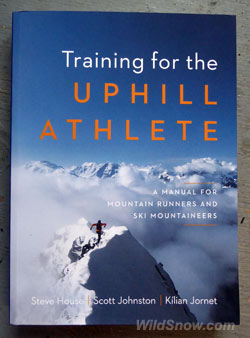
Training for the Uphill Athlete
Are you self coaching an athletic life? If so, chances are you are an uphiller. And chances are you’ve spent years searching for tips on increasing the specificity of your training, as well as avoiding over-use and health issues caused by exercise addiction. Well, here it is, your coach in exposital prose; 369 pages of secret knowledge from world-class alpinist Steve House, coaching wizard Scott Johnston, and none other than The Jornet, who needs no qualifier.
I’ve turned the book over to a self-coached skimo guy for his detailed hands-on review. Below outlines what you get for a couple dozen dollars.
The tome (and that’s accurate, use it for weight training) is broken into four sections. The first will transform you to a Doctor of sport physiology. Yeah, perhaps I overstated that. But rest assured that chapters and sections dealing with everything from Darwin to the role of fat cells will keep you in your chair, under your reading light.
Second section will get you rising from said chair — but don’t head for your lycra yet. Sit back down. Here we have the methods, concepts, terms, principles. More physiology, but Jornet takes us back to the primal: “I don’t need a watch anymore,” he writes. “I can tell you my heart rate within a few beats per minute, simply by feel.” I thought only gurus in Indian ashrams could do that. I stand corrected.
Third section: Strength, baby. While the authors make it clear early-on that your cardio base is the door to happiness, they also show you need structure. So, eventually, strength training comes. Do it randomly at your peril. Moving the human curpo uphill requires specific muscle interplay. Scientific workout plans required. Don’t have a strength coach? This section is for you.
Section Four is what you came for: “How to Train.” You get five chapters here that hit concepts of planning and periodicity. Two specific chapters cover special considerations for ski mountaineering as opposed to mountain running.
This is not only a training manual. It’s also inspirational reading. The book includes innumerable vignettes they call “Athlete Stories.” Brilliant. Do your well planned workout, then head back to your recovery chair (the word “recliner” is banned) and enjoy tales from the hills, roads, and trails. Janelle Smiley, Jornet, Rickey Gates, Mike Foote, Anton Krupicka. If I kept name dropping I’d get punished by Google for word packing.
Bonus: The book goes thick because it’s loaded with full-page color hero shots. Know who Laetitia Roux is? How about her partner for Pierra Menta first place (2017), Emelie Forseberg? Buy the book. Razor out page 360, place on workout room wall. Verso is your example of “Category 2 Mountain Runner Early Base Period Week” schedule. You will be conflicted as to which side you’ll display. Both will inspire in different ways.
Don’t miss Training for the Uphill Athlete. It’s said to already be in the warehouse, retailing any day. Appears to be available from the rain forest. Best seller!
WildSnow.com publisher emeritus and founder Lou (Louis Dawson) has a 50+ years career in climbing, backcountry skiing and ski mountaineering. He was the first person in history to ski down all 54 Colorado 14,000-foot peaks, has authored numerous books about about backcountry skiing, and has skied from the summit of Denali in Alaska, North America’s highest mountain.
